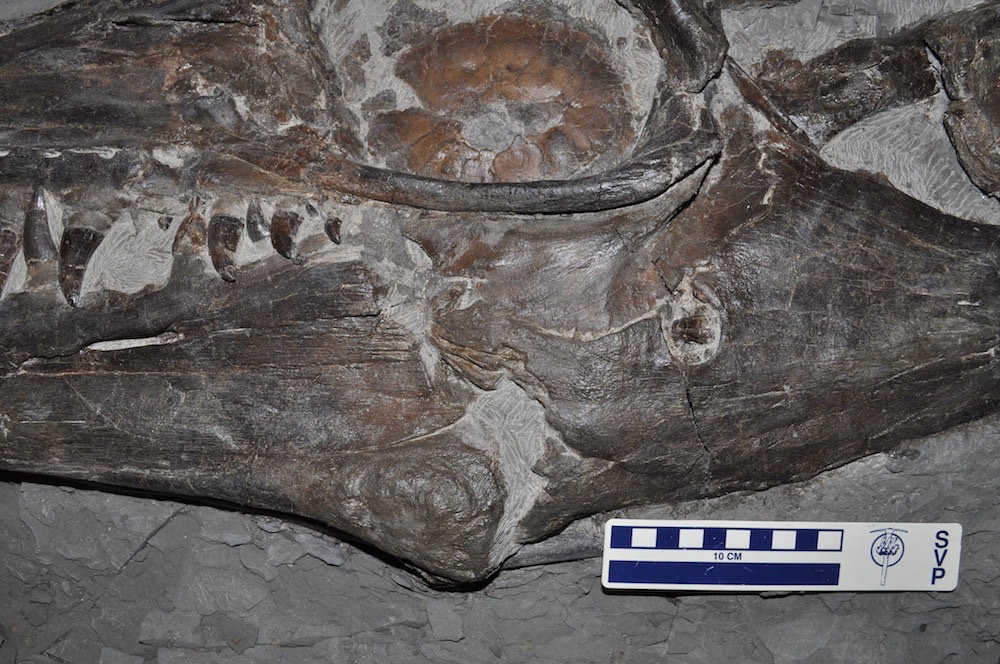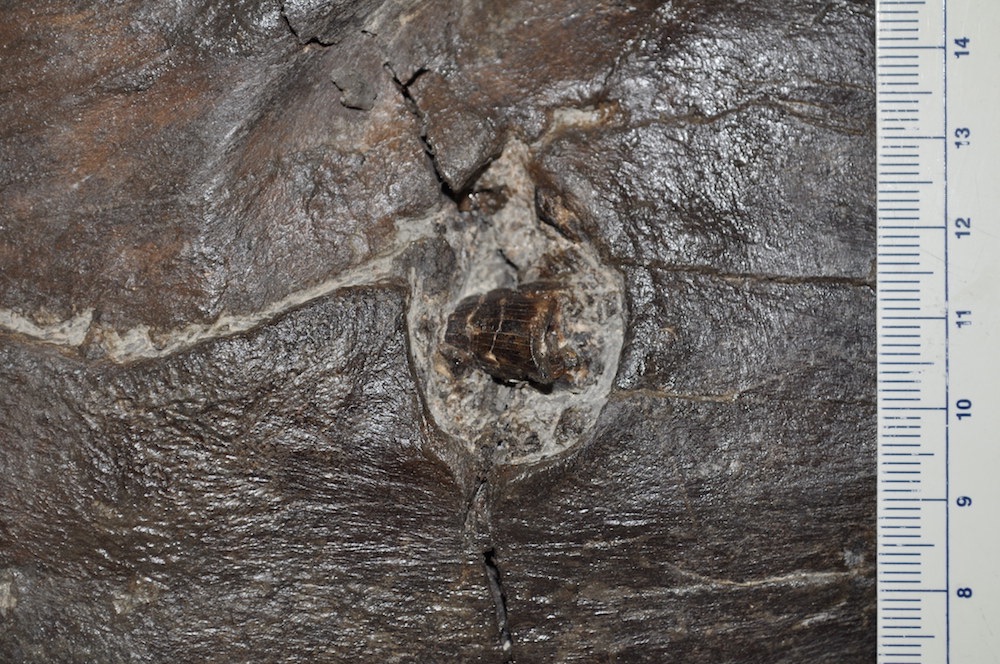Ancient Battle Left 'Sea Monster' With Tooth Stuck in Its Face

SALT LAKE CITY — About 75 million years ago, a mosasaur — a dolphin-like, predatory, marine reptile that lived during the dinosaur age — bit another mosasaur so hard that it left its tooth behind, embedded in its foe's face, new research finds.
Now, paleontologists are studying the remains of the victim, a creature that sustained not one, but two attacks on its face, likely from different adversaries, said paleontologist Takuya Konishi, an assistant professor at the University of Cincinnati.
"The specimen represents the first direct, unequivocal evidence of nonlethal biting, and not predation, between mosasaurs," Konishi told Live Science, here at the 76th annual meeting of the Society of Vertebrate Paleontology. [T. Rex of the Seas: Images of Fierce Mosasaurs]
A mining company discovered the 21-foot-long (6.5 meters) specimen in southern Alberta, Canada, in 2012, and promptly shared the news with the Royal Tyrrell Museum of Palaeontology. Museum researchers spent two years preparing the fossil, "during which [time] the specimen's unique scientific significance became clear: It had a tooth from another mosasaur embedded in its lower jaw," Konishi said. "We were all thrilled, and began working on it."
The 74.8-million-year-old mosasaur was fully articulated, meaning that all of its bones were preserved in place. An analysis of the creature's anatomy, with the help of a computed tomography (CT) scan, suggests that it was a species in the Mosasaurus genus, Konishi said.

The remnants of the mosasaur attack — three lesions in all, including the still-embedded tooth — are visible on the left side of the mosasaur's face. All three lesions show signs of bone remodeling, indicating that the mosasaur survived the attack and began healing before the animal's demise, Konishi said.
However, two genuses of mosasaurs lived in the region where the specimen was found, and it wasn't immediately clear which had bitten the victim. Mosasaurs in the genus Prognathodon had powerful teeth that could crunch through turtle shells, so it's unlikely that one of them would have broken a tooth while attacking another mosasaur, Konishi said.
Sign up for the Live Science daily newsletter now
Get the world’s most fascinating discoveries delivered straight to your inbox.
Rather, a mosasaur in the genus Mosasaurus was a likelier assailant, as these animals had long and pointy teeth that were more prone to breaking, Konishi said. The researchers found no evidence of any Mosasaurus bites on the other side of the victim's face, suggesting that the attacker came at its target at an angle from below, Konishi added.
Perhaps competition for a mate sparked the Mosasaurus-on-Mosasaurus fight, Konishi said. Mosasaurs are related to squamates, scaled reptiles such as snakes and lizards. Mosasaurs are extinct, but their distant relatives, squamates called gila monsters (Heloderma suspectum) are known to fight when competing for female mates, Konishi said. The male monsters will bite the underside of their opponents' throats as a way to prevent the other from biting back, Konishi said.
"It is possible that a similar tactic was employed by the mosasaur individual that left its tooth in [the newfound specimen], where the bite was from one side of the jaw and from underneath — forceful enough to subdue the opponent but not to kill it," Konishi wrote in a preliminary draft of the study's abstract.

The right side of the mosasaur's skull also showed bite marks, but there was less bone remodeling, indicating that the animal was bitten not long before it died, Konishi said. Moreover, these bite marks did not come from another Mosasaurus, and the assailant's identity is still unknown, Konishi said.
This isn't the first time scientists have found evidence of mosasaurs going after their own kind. In 2013, researchers reported finding a fossilized mosasaur in Angola with the partial remains of three other mosasaur species in its gut.
The new study has yet to be published in a peer-reviewed journal.
Original article on Live Science.

Laura is the archaeology and Life's Little Mysteries editor at Live Science. She also reports on general science, including paleontology. Her work has appeared in The New York Times, Scholastic, Popular Science and Spectrum, a site on autism research. She has won multiple awards from the Society of Professional Journalists and the Washington Newspaper Publishers Association for her reporting at a weekly newspaper near Seattle. Laura holds a bachelor's degree in English literature and psychology from Washington University in St. Louis and a master's degree in science writing from NYU.










